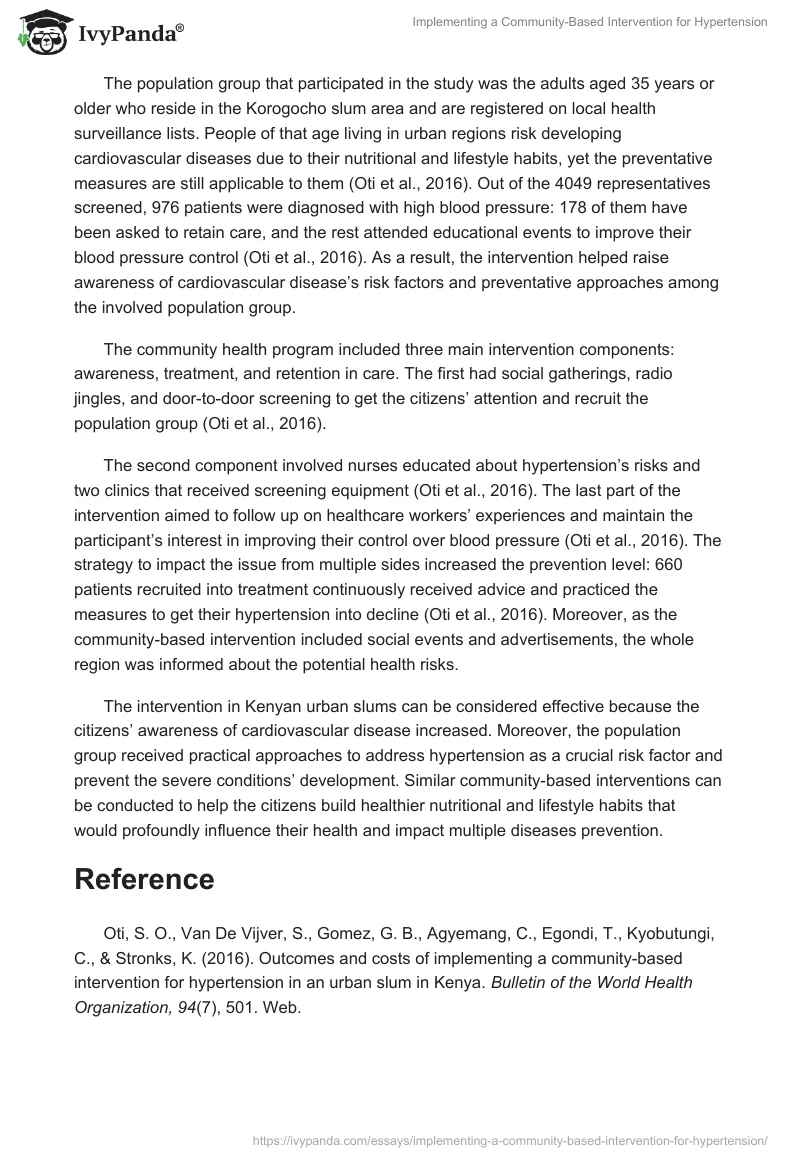Cardiovascular diseases are the leading death cause worldwide, and multiple interventions attempt to decrease the number of severe cases. Oti et al. conducted the study “Outcomes and costs of implementing a community-based intervention for hypertension in an urban slum in Kenya” in 2012-2013 and published the results in 2016. The research has been published in the World Health Organization’s Bulletin and is dedicated to implementing a community-based approach to decreasing diseases by addressing the hypertension cases in Kenya’s urban slums (Oti et al., 2016). This paper aims to discuss the outcomes of the intervention and analyze the prevention effectiveness of such programs.
The community health issue addressed in the study is Kenya’s city’s inhabitants’ lacking knowledge about cardiovascular diseases’ causes and prevention measures performed. Oti et al. (2016) state that “the rising burden of hypertension in low- and middle-income countries is amplified by the public’s low levels of awareness among slum residents as a large portion of neglected urban populations” (p. 501).
Implementation of the intervention program aimed to educate nursing professionals, consult Kenyan citizens listed in the health and demographic surveillance system, and improve hypertension treatment in local hospitals (Oti et al., 2016). The community-based approach helped to increase the awareness of the health issue and encouraged urban slums’ inhabitants to include cardiovascular disease prevention measures in their lives.
The intervention conducted in Nairobi’s slums attempted to control hypertension as a crucial cardiovascular disease risk factor. While community health programs might not make significant changes in the medical treatment strategies, they can help develop preventative attitudes to decrease the number of affected people. As a result, 660 patients were recruited to participate in the intervention, and 9% of them got their blood pressure under control by the sixth clinical visit (Oti et al., 2016). The community health program increased the citizens’ awareness about hypertension as a cardiovascular disease risk factor and improved several participants’ health conditions.
The population group that participated in the study was the adults aged 35 years or older who reside in the Korogocho slum area and are registered on local health surveillance lists. People of that age living in urban regions risk developing cardiovascular diseases due to their nutritional and lifestyle habits, yet the preventative measures are still applicable to them (Oti et al., 2016). Out of the 4049 representatives screened, 976 patients were diagnosed with high blood pressure: 178 of them have been asked to retain care, and the rest attended educational events to improve their blood pressure control (Oti et al., 2016). As a result, the intervention helped raise awareness of cardiovascular disease’s risk factors and preventative approaches among the involved population group.
The community health program included three main intervention components: awareness, treatment, and retention in care. The first had social gatherings, radio jingles, and door-to-door screening to get the citizens’ attention and recruit the population group (Oti et al., 2016).
The second component involved nurses educated about hypertension’s risks and two clinics that received screening equipment (Oti et al., 2016). The last part of the intervention aimed to follow up on healthcare workers’ experiences and maintain the participant’s interest in improving their control over blood pressure (Oti et al., 2016). The strategy to impact the issue from multiple sides increased the prevention level: 660 patients recruited into treatment continuously received advice and practiced the measures to get their hypertension into decline (Oti et al., 2016). Moreover, as the community-based intervention included social events and advertisements, the whole region was informed about the potential health risks.
The intervention in Kenyan urban slums can be considered effective because the citizens’ awareness of cardiovascular disease increased. Moreover, the population group received practical approaches to address hypertension as a crucial risk factor and prevent the severe conditions’ development. Similar community-based interventions can be conducted to help the citizens build healthier nutritional and lifestyle habits that would profoundly influence their health and impact multiple diseases prevention.
Reference
Oti, S. O., Van De Vijver, S., Gomez, G. B., Agyemang, C., Egondi, T., Kyobutungi, C., & Stronks, K. (2016). Outcomes and costs of implementing a community-based intervention for hypertension in an urban slum in Kenya. Bulletin of the World Health Organization, 94(7), 501. Web.


